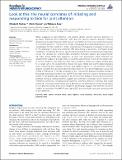Look at this: the neural correlates of initiating and responding to bids for joint attention
Author(s)
Redcay, Elizabeth; Kleiner, Mario; Saxe, Rebecca R.
DownloadRedcay-2012-the neural correlates of initiating and responding.pdf (1.255Mb)
PUBLISHER_POLICY
Publisher Policy
Article is made available in accordance with the publisher's policy and may be subject to US copyright law. Please refer to the publisher's site for terms of use.
Terms of use
Metadata
Show full item recordAbstract
When engaging in joint attention, one person directs another person's attention to an object (Initiating Joint Attention, IJA), and the second person's attention follows (Responding to Joint Attention, RJA). As such, joint attention must occur within the context of a social interaction. This ability is critical to language and social development; yet the neural bases for this pivotal skill remain understudied. This paucity of research is likely due to the challenge in acquiring functional MRI data during a naturalistic, contingent social interaction. To examine the neural bases of both IJA and RJA we implemented a dual-video set-up that allowed for a face-to-face interaction between subject and experimenter via video during fMRI data collection. In each trial, participants either followed the experimenter's gaze to a target (RJA) or cued the experimenter to look at the target (IJA). A control condition, solo attention (SA), was included in which the subject shifted gaze to a target while the experimenter closed her eyes. Block and event-related analyses were conducted and revealed common and distinct regions for IJA and RJA. Distinct regions included the ventromedial prefrontal cortex for RJA and intraparietal sulcus and middle frontal gyrus for IJA (as compared to SA). Conjunction analyses revealed overlap in the dorsal medial prefrontal cortex (dMPFC) and right posterior superior temporal sulcus (pSTS) for IJA and RJA (as compared to SA) for the event analyses. Functional connectivity analyses during a resting baseline suggest joint attention processes recruit distinct but interacting networks, including social-cognitive, voluntary attention orienting, and visual networks. This novel experimental set-up allowed for the identification of the neural bases of joint attention during a real-time interaction and findings suggest that whether one is the initiator or responder, the dMPFC and right pSTS, are selectively recruited during periods of joint attention.
Date issued
2012-05Department
Massachusetts Institute of Technology. Department of Brain and Cognitive SciencesJournal
Frontiers in Human Neuroscience
Publisher
Frontiers Research Foundation
Citation
Redcay, Elizabeth, Mario Kleiner, and Rebecca Saxe. “Look at This: The Neural Correlates of Initiating and Responding to Bids for Joint Attention.” Frontiers in Human Neuroscience 6 (2012).
Version: Final published version
ISSN
1662-5161